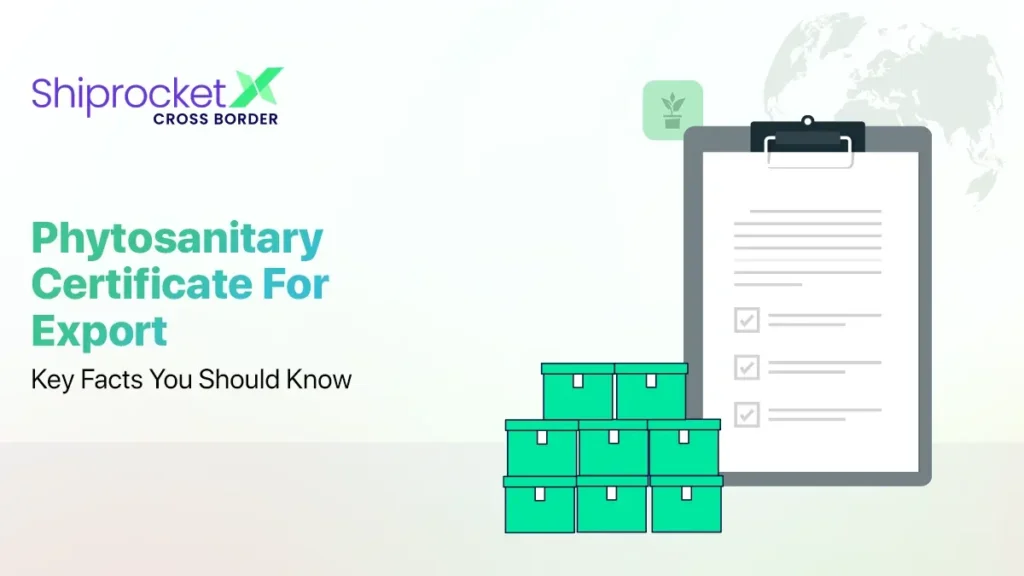How to Obtain a Phytosanitary Certificate for Export | Guide
- Purpose of a Phytosanitary Certificate
- Why Are Phytosanitary Certificates Important for Exporting?
- Products that Require a Phytosanitary Certificate
- Types of Phytosanitary Certificates
- Required Documents for Obtaining a Phytosanitary Certificate
- Step-by-Step Guide to Obtaining a Phytosanitary Certificate
- Online Application Process – Detailed Steps
- How ShiprocketX Supports Sellers with Phytosanitary Certification
- Conclusion
It is important to ensure that the goods you are exporting meet international health standards. When it comes to plant-based products, phytosanitary certificates for export serve as proof that your products are free from pests and diseases and comply with the importing country’s regulations. Understanding the importance of phytosanitary certificates is essential for a successful export process. In this article, we have shared everything you need to know about obtaining and managing these certificates. Read on to find out!

Purpose of a Phytosanitary Certificate
A phytosanitary certificate verifies the quality of a plant or plant products to be shipped overseas. Different countries require compliance with different regulations related to exported goods. Issued by the National Plant Protection Organisation, a Phytosanitary certificate is essential for Indian exporters to assure that only high-quality plant- based products are exported from the country. It is necessary to ensure that international trade of these products is carried out safely without the risk of spreading pests or related illnesses.
This prior verification reduces the chances of a shipment being rejected at a later stage. Thus, it prevents delays and possible financial losses.
Why Are Phytosanitary Certificates Important for Exporting?
Phytosanitary certificates are critical for exporting because they certify that the products are free from harmful pests and diseases. This helps prevent the spread of these threats across borders. Without a phytosanitary certificate, plant products may be denied entry in many countries. They are likely to be destroyed or returned to the exporter, leading to financial losses and also tarnishes ones reputation.
By obtaining this certificate, you can ensure smooth international trade and build trust among global customers and trading partners.
Products that Require a Phytosanitary Certificate
A Phytosanitary Certificates for Export is required for the following products:
- Plant cuttings, bulbs, and other plant parts
- Seeds
- Grains
- Fresh fruits and vegetables
- Herbs
- Wood and wood products
- Cotton
- Fresh-cut flowers and decorative foliage
Types of Phytosanitary Certificates
There are two types of phytosanitary certificates:
- Phytosanitary Certificate for Export
This is an essential document for exporters dealing with plant-based products. It verifies that the products meet the health standards of the importing country and are free from pests and possible illnesses they may cause. By obtaining this certificate, exporters can ensure smooth entry of their products into foreign markets and avoid rejections or delays.
- Phytosanitary Certificate for Re-Export
It is issued when a plant-based product imported into a country is re-exported to another. This certificate verifies that the product has been inspected and meets the phytosanitary requirements of the importing country. The process involves verifying that the original phytosanitary certificate is still valid and that the product has not been exposed to any new pests or diseases in the re-exporting country.
Key Information Included in a Phytosanitary Certificate
- Name of the Exporter
- Name of the Importer
- Exporter and Importer’s address
- Information about the consignment, including the quantity, packaging, and other details of the products being exported
- Information about phytosanitary treatment if the products have been treated for pests
- Inspection details, including the location and date of inspection and the name and signature of the inspector
- Declaration about the authenticity of the information provided in the certificate and compliance with the phytosanitary requirements
Required Documents for Obtaining a Phytosanitary Certificate
In addition to the completed application form required for applying for a phytosanitary certificate, you must submit the following documents to obtain the certificate:
- Commercial invoice containing details about the plant products being exported and the terms of sale between importer and exporter
- Detailed packing list of the shipment, including the weight and dimensions
- Bill of Lading
- The original phytosanitary certificate from the country of origin if the product is being re-exported
- Inspection report from a certified inspector who has examined the products for pests and diseases
- Treatment certificate if the products have undergone any pest control treatments
- Certificate of origin to confirm the country in which the products being exported were produced
- An export license may be needed for some products and destinations
Any additional documents that may be requested depending on the specific product and destination requirements
Step-by-Step Guide to Obtaining a Phytosanitary Certificate
Here is the step-by-step guide to get a Phytosanitary certificate:
- To begin with, contact the exporting country’s National Plant Protection Organisation (NPPO) to seek guidance about the requirements to be fulfilled for the products to be exported.
- Collate the necessary documentation to apply for a phytosanitary certificate for export and obtain it. Application forms to apply for the same, packing list, export licence, certificate of origin, and commercial invoice are required for the process.
- Make arrangements for the inspection of plants and plant-based products. If necessary, arrange for phytosanitary treatment of the same.
- Submit the phytosanitary certificate application and the essential documents to the NPPO of the exporting country.
- On approval of the application, the phytosanitary certificate is issued to the exporter.
- Thereafter, the exporter needs to provide the phytosanitary certificate to the importer, who in turn presents it to the authorities of the importing country.
Online Application Process – Detailed Steps
Here’s the step-by-step process to apply for a phytosanitary certificate:
- Visit the Plant Quarantine Information System’s website.
- Click on the sign-up link and fill in details such as name, address, importer and exporter status, contact number, email ID, and the importer exporter code shared by DGFT.
- Select the Plant Quarantine Station you want to register with, fill out the registration form, and submit it.
- Thereafter, your request will be forwarded for validation.
- Your account will be activated after validation and you shall receive a confirmation via email.
- Log on to the system and select Apply Online.
- Select the appropriate certificate type.
- Enter the required fields and submit.
- Phytosanitary certificate will be issued after inspection and essential testing.
How ShiprocketX Supports Sellers with Phytosanitary Certification
ShiprocketX eases the export of plants and plant products by helping the sellers obtain phytosanitary certification to verify that the products comply with international plant health standards. The professionals at ShiprocketX provide guidance on the necessary documentation to ensure that all the plant products meet the stringent requirements of the destination country. Moreover, they coordinate with authorised agencies to facilitate inspections. This support helps in maintaining compliance and speeds up the certification process.
Conclusion
A phytosanitary certificate for export is required to ensure that plants and plant-based goods being shipped overseas meet international health standards. Products include plants, seeds, fresh fruits, vegetables, herbs, cotton, fresh-cut flowers, bulbs, plant cuttings, wood products, etc. Issued by the National Plant Protection Organisation, the certificate verifies that products are free from pests and diseases.
The need for this certificate depends on the destination country’s regulations and the type of products being exported. The application process involves filling and submitting a form followed by a detailed inspection of the products to be exported. The application must be accompanied by documents such as a commercial invoice, packing list, certificate of origin, and bill of lading. The step by step procedure to obtain the certificate has been shared above. By obtaining the certificate timely, you can prevent delays at customs and avoid the rejection of goods. It ensures smooth trade operations.




